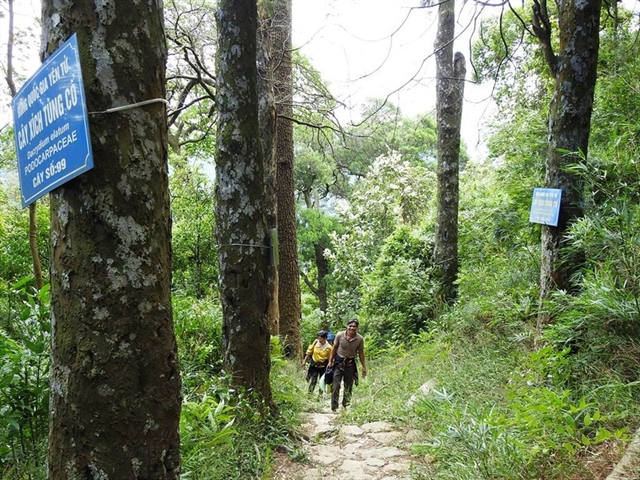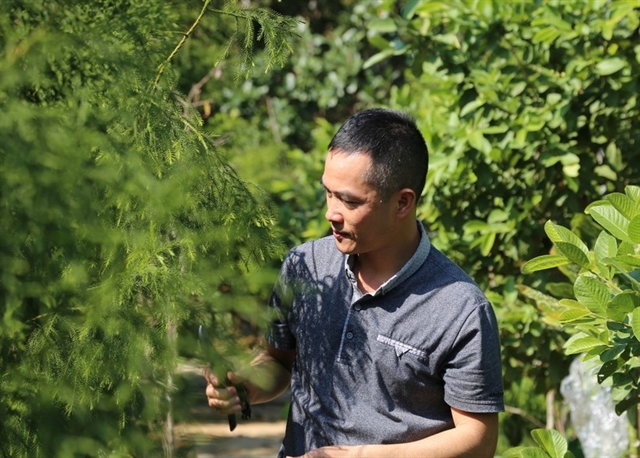 Environment
Environment

 |
| Ancient xích tùng trees in the Yên Tử National Forest in the northern province of Quảng Ninh. — Photos giaoducthoidai.vn |
QUẢNG NINH — Phạm Văn Sự, a 44-year-old man in Uông Bí City in the northern province of Quảng Ninh has dedicated more than two decades to studying methods for propagating and conserving the xích tùng pine species, a valuable tree at risk of extinction in Việt Nam.
After numerous failed attempts, Sự succeeded in propagating over 2,000 trees. Among them, nearly 1,000 have been entrusted to and planted in the Yên Tử National Forest. These trees are currently thriving in their natural environment.
Sự said he has a special affinity with this tree species. In 2001, after graduating from the Environment Faculty at the University of Natural Sciences in Quảng Ninh Province, he began working for the Yên Tử National Forest and Monument Management Board.
For the job, he frequently travelled to various heritage sites, passionately admiring ancient xích tùng trees because ‘they symbolise the vigorous vitality, noble spirit and integrity of a true gentleman’.
Xích tùng, also known as hoàng đàn giả or hồng tùng, is listed in the Vietnam Red Data Book. Ancient xích tùng trees in the Yên Tử National Forest are distributed quite widely, ranging from 400m to 700m in altitude. The tree stands at 327m in Am Lò Rèn at the lowest, and at 748m in front of Bảo Sái Pagoda at the highest.
Witnessing some ancient trees over 700 years old in the Yên Tử National Forest dying due to termites and pests in 2002, Sự realised that if the situation did not improve, the rare and precious trees would no longer exist.
He decided to try propagating them.
After work hours, Sự roamed the forest to find xích tùng seeds, which are as small as grains of rice and easily blend into the rocky soil. The number of seeds produced is very low, and they rot quickly and are often eaten by insects.
Sự found out why no naturally propagated xích tùng trees have appeared. The ancient xích tùng forest in the Yên Tử National Forest was planted by ancestors, arranged in rows and in special locations.
Currently, there are about 70 trees planted on both sides of the pilgrimage route.
In 2002, Sự tried germinating the first batch of xích tùng seeds. Seven months later, 80 per cent of the seeds had sprouted, but the survival rate was low, with sporadic deaths due to root rot.
Sự didn't give up. He tried every possible way to nurture the trees, but they only survived for a short period.
 |
| Phạm Văn Sự tends xích tùng trees in his garden. |
In 2010, Sự finally succeeded in propagation with 80 thriving xích tùng trees. He handed over 16 trees to the management board of Yên Tử National Forest and Monument to plant near their headquarters.
He also planted around 50 trees in his garden and gave some to friends from all regions to try planting to see if they were suitable for the climate and soil. This time, all these trees adapted well.
Also in the same year, Sự embarked on grafting experiments, and it took another five years to gain success.
Currently, his garden boasts over 2,000 trees, including nearly 300 trees ranging from 1 to 4.5 metres tall propagated from seeds, and 1,750 trees ranging from 0.1 to 0.6 metres tall propagated by grafting.
In order to successfully propagate and cultivate the xích tùng tree species, Sự studied the planting methods of his predecessors, in which sunlight exposure was crucial.
“Xích tùng trees will perish without sunlight. Therefore, all the ancient xích tùng trees on Yên Tử are situated on slopes or in locations where the land is uneven, providing optimal sunlight exposure,” he told the Giáo dục & thời đại (Education and Era) online newspaper.
According to Sự, xích tùng seeds will germinate when they are put on trays and need soil from the base of the parent xích tùng tree, as symbiotic fungi exist there. The surrounding soil should be mixed with sand and compost for optimal germination, then lime should be scattered around to ward off ants and termites. Leaves should cover the surface to deter insects.
Sự also said that manual labour remains his primary method. To Sự, every seed is like a nugget of gold because it signifies an opportunity to prevent the extinction of this species.
Sự has handed over 1,065 xích tùng trees taller than 1 metre to the Management Board of Yên Tử National Forest and Monument. These trees have been planted in the Yên Tử Forest and can thrive in their natural environment.
All newly planted xích tùng trees have been fenced off for convenient inspection and care.
Lê Tiến Dũng, head of the Management Board, stated that Sự has achieved the most successful propagation and is most dedicated to this species.
He also said that there are still about 230 xích tùng trees over 700 years old in the Yên Tử National Forest.
In 2019, a project to preserve ancient xích tùng trees in the forest was implemented. The total budget for the project was over VNĐ26 billion, lasting five years.
The management board cooperated with the Institute of Tropical Forestry Research and Development to examine and treat 233 ancient xích tùng trees.
Currently, experts and scientists continue to implement treatment for pest and disease control for these xích tùng trees, he said. VNS




